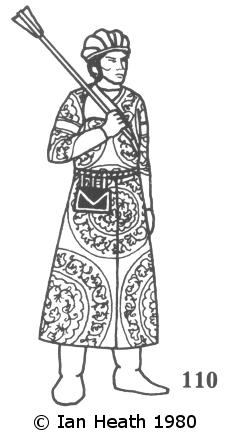
Try Amazon Audible Premium Plus and Get Up to Two Free Audiobooks


This is based on murals discovered in 1949 in the Ghaznavid palace of Lashkari Bazar in Afghanistan, the only known pictorial representations of ghulams in ceremonial dress. They date to the 11th century but ghulams would have been similarly equipped throughout this period. No uniformity of dress is apparent.
In the written sources ceremonial dress was of embroidered silk and brocade, while equipment was heavily ornamented; shields were decorated with silver and gold and were sometimes bejewelled, while weapons too had gold and silver mountings - some maces even appear to have been solid gold! Ornamental belts were also worn, indicative of the original composition of the ghulam slave soldiers (see 85); those of palace ghulams were usually gold, often decorated with precious stones. As well as the mace a sword, short spear and bow were normally carried.
A late-11th century author, ostensibly describing the training of ghulams in the service of the Samanids, records that they underwent a 7 year course. They only received the characteristic mace, together with richly embroidered clothing, in their fifth year, a full-dress ceremonial uniform in the sixth year, and became junior officers in the seventh and eligible to wear a black felt hat decorated with silver lace.
The long topcoats often worn by Asiatic peoples were much the same as that shown here.